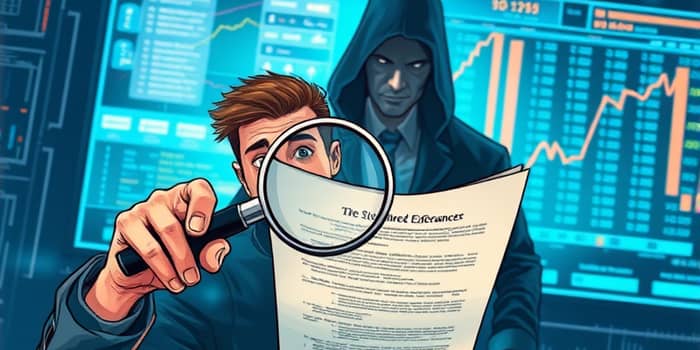
Every year, millions fall prey to insidious financial scams, suffering monetary and emotional wounds that can take years to heal. In 2024, reported losses in the U.S. surged to $12.5 billion, a staggering 25% rise from the previous year. With only 4% of victims ever recovering their funds, the stakes have never been higher.
Beyond dollars lost, scams leave behind shattered trust and lingering anxiety. Recognizing deceit before it strikes empowers you to protect not just your wallet but your peace of mind. This comprehensive guide will illuminate the warning signs, explain evolving tactics, and provide actionable defense strategies.
Consumer reports reveal that 38% of fraud victims in 2024 suffered direct financial losses, compared to 27% in 2023. Worldwide, scams now siphon over $1 trillion annually, leaving a trail of broken livelihoods. Each statistic represents real people confronting betrayal and insecurity.
Investment scams remain the top culprit, accounting for $5.7 billion in losses last year alone. Imposter schemes claimed $2.95 billion, including an alarming $789 million impersonating government officials. Check fraud and synthetic identity theft continue to climb, with businesses reporting $1.3 billion in check-related losses and a 28% annual rise in fake-identity fraud.
The human cost extends beyond finances. Victims frequently report stress, shame, and isolation when they realize they’ve been deceived. By spotting scams early, you can avoid these negative experiences and maintain your sense of control. As scammers refine their methods, the speed at which funds can be stolen has accelerated, leaving little time for recourse.
Scammers blend traditional methods with cutting-edge technology, aiming to catch you off-guard across multiple channels. Be on the lookout for:
These approaches are designed to mimic legitimate communications, exploiting trust in familiar brands or authorities. Never let the medium lull you into complacency.
Even when interactions appear genuine, pause and verify before taking any action—your vigilance can derail the most sophisticated schemes. Remember, authenticity checks like verifying caller ID and sending confirmation emails can thwart even the slickest approaches.
Fraudsters have refined their craft, deploying tactics that prey on your emotions and leverage new technologies:
These high-tech deceptions often accompany narratives of emergency or exclusivity, forcing hasty decisions. Always question unexpected or overly persuasive messages, no matter how polished they appear. These multi-layered strategies are orchestrated to disarm your logical defenses and tap directly into emotional impulses.
Develop an eye for the indicators that a deal is too dangerous to trust. Watch for:
Unsolicited contacts demanding urgent response—legitimate opportunities rarely arrive with panicked calls or emails.
Guarantees of risk-free or extraordinary returns—every investment involves trade-offs and uncertainties.
Requests for unconventional payments like cryptocurrency, gift cards, or wiring funds to personal accounts.
Demands for login credentials or remote access to your devices, banking apps, or accounts under the guise of “security checks.”
Monitor your accounts for anomalies. Multiple deposits and withdrawals outside your normal patterns or transactions that mismatch your income level can signal synthetic identity or check fraud.
Building a robust defense involves skepticism and methodical verification. Always take these precautions:
Pause and research before deciding on any deal. If you feel rushed, take a step back—authentic professionals will respect your need for time.
Trust your instincts and verify by checking registration status on sites like Investor.gov or the FCA’s ScamSmart. Employ two-factor authentication and password managers to strengthen account security, and never share credentials.
Maintain separate email accounts for financial services and regular correspondence, and ensure your devices run the latest security patches.
Immediate action can minimize harm. If you detect suspicious behavior:
Immediately hang up and ignore any further communication from the suspect party.
Contact your bank to review recent transactions and consider placing a temporary hold or freeze on your account. File a report with the Federal Trade Commission, local law enforcement, and, if relevant, your country’s financial regulator.
Inform credit bureaus to add a fraud alert or credit freeze on your profile. Collect all relevant evidence, including emails, call logs, and screenshots, to assist investigators and protect your rights.
Vigilance is not a one-time effort but an ongoing mindset. Educate your friends, family, and colleagues—especially seniors and those less familiar with digital finance—about scam trends and protective measures.
Stay vigilant against emotional manipulation by pausing before reacting to fear or urgency. Schedule regular reviews of your financial statements and set up automatic alerts for large or unusual charges.
Consider organizing or attending community workshops on fraud prevention, and encourage workplaces to include scam awareness in training programs. By fostering a network of informed individuals, you create a collective barrier against scammers.
Stay updated on emerging scams by subscribing to official alerts and attending free webinars offered by consumer protection agencies.
The battle against financial fraud evolves with each technological advance. By remaining informed, questioning suspicious activities, and implementing strong safeguards, you can outsmart fraudsters and protect both your assets and your peace of mind.
Your vigilance today builds a safer tomorrow—for you and everyone around you. Every precaution you take not only shields you from risk but also strengthens the broader community against the persistent threat of financial scams.
References













